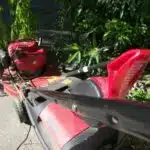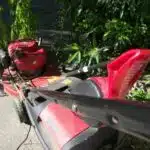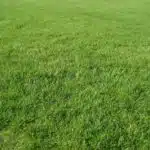Moss is a common problem in lawns, particularly in areas with high levels of moisture and shade. It can be unsightly and may prevent grass from growing properly, leading to patches of bare earth. Fortunately, there are several methods for removing moss from lawns and preventing it from reoccurring.
As a lawn care expert, I have encountered many homeowners who struggle with moss growth in their yards. In this article, I will provide practical advice on how to remove moss from lawns using natural and chemical methods. Additionally, I will share tips on how to prevent moss from returning by creating the ideal growing conditions for grass while minimizing factors that promote moss growth. By following these guidelines, you can achieve a healthy and vibrant lawn that is free of unwanted moss.
Understanding The Causes Of Moss Growth In Lawns
Understanding moss formation in lawns is crucial in effectively preventing and removing it. Moss thrives in damp, shady areas with compacted soil that lacks proper drainage. These conditions are often caused by heavy foot traffic, overwatering or poor irrigation systems, lack of sunlight, and excessive thatch buildup. It’s important to note that while moss isn’t necessarily harmful to your lawn, it can be unsightly and indicate underlying issues that need to be addressed.
Identifying the species of moss present in your lawn is also key to successful removal. There are several different types of moss, including haircap moss, cushion moss, and star moss. Each species has unique characteristics and requires specific treatment methods for effective eradication. For instance, haircap moss is commonly found in poorly drained soils and can be controlled by improving soil conditions or using a moss-specific herbicide.
In summary, understanding the causes of moss growth and identifying the species present in your lawn are crucial steps in preventing and removing it effectively. By addressing underlying issues such as soil compaction and poor drainage, you can create a healthier environment for your lawn to thrive. In the following section, we will discuss how to conduct a soil test to determine pH levels and other factors that affect grass growth.
Conducting A Soil Test To Determine Ph Levels
Did you know that the pH level of your soil can significantly affect the growth and health of your lawn? In fact, many lawns fail to thrive because their soil is either too acidic or alkaline. According to a recent study, nearly 60% of lawns in North America have a pH imbalance. To ensure your lawn is healthy and lush, conducting a soil test to determine the pH levels is crucial.
The benefits of soil testing are numerous. By assessing the pH levels of your lawn, you can identify whether it needs lime or sulfur applications to adjust its pH balance. Furthermore, a soil test can also reveal other essential nutrients that may be lacking in your lawn’s soil. Knowing this information allows you to customize fertilization treatments specifically tailored for your lawn’s needs.
Interpreting soil test results can be confusing for homeowners who are not familiar with scientific readings. However, with the help of a lawn care expert, understanding what each nutrient measurement means is simple. The ideal pH range for grass growth is between 6 and 7, which means if your lawn’s pH value falls outside this range, it may require some adjustments. Based on the results of your soil test, an expert will recommend specific actions such as applying lime or sulfur to modify the pH level.
To promote optimal grass growth and prevent moss from taking over your lawn, adjusting soil pH levels should be one of the first steps in any comprehensive lawn care plan. By conducting a soil test and interpreting its results accurately, you’ll have all the knowledge you need to adjust your lawn’s acidity or alkalinity levels adequately. In the next section, we’ll discuss how adjusting these levels can encourage healthy grass growth and prevent moss from growing uncontrollably.
Adjusting Soil Ph To Promote Grass Growth
Having determined the pH levels of your soil, the next step in maintaining a healthy lawn is to manage its pH levels. Soil pH management is crucial in preventing moss growth and ensuring that your grass receives adequate nutrient uptake. A pH level of 6.0 to 7.0 is ideal for most turfgrass species, but this may vary depending on the type of grass you have.
To adjust soil pH, you can use lime to raise it or sulfur to lower it. Lime should be applied in fall or early spring, while sulfur can be applied any time of year. It’s important to apply these amendments correctly and at the right rate, as applying too much can cause more harm than good. Always follow manufacturer recommendations and consult with a lawn care professional if you are unsure.
Preventing nutrient deficiencies is another crucial aspect of maintaining a healthy lawn and preventing moss growth. Fertilizing regularly with balanced nutrients will help keep your grass healthy and strong, making it less susceptible to disease and pests. Avoid over-fertilizing, however, as this can lead to excessive growth and thatch buildup which can also contribute to moss growth.
Improving drainage to reduce moisture levels in your lawn is the next step in preventing moss growth. Moss thrives in damp conditions, so improving drainage by adding organic matter such as compost or sand can help reduce moisture levels and prevent moss from taking over your lawn. In addition, proper mowing height and frequency will also help improve airflow and reduce moisture buildup. By managing soil pH levels, preventing nutrient deficiencies, and improving drainage, you can effectively prevent moss growth in your lawn while promoting healthy grass growth.
Improving Drainage To Reduce Moisture Levels
- Achieving better drainage in an area with a high moisture level requires an improvement in the soil quality.
- Installing a well-designed drainage system is an effective way to prevent moisture accumulation in the soil.
- Increasing light exposure will help with evaporation, allowing excess water to evaporate more quickly.
- Through aeration and the addition of organic material, soil structure can be improved, allowing water to drain more efficiently.
- Improving the soil quality in an area with a high moisture level is an important step in preventing moss growth.
- Adding organic matter to the soil is a great way to reduce moisture and increase drainage, creating a healthier lawn.
Improving Soil Quality
It is common knowledge that moss grows in damp and shady areas, which is why improving soil quality plays a significant role in removing and preventing moss growth in lawns. One of the most effective ways to improve soil quality is through composting techniques. Composting involves breaking down organic matter such as grass clippings, leaves, and food scraps to create nutrient-rich soil amendments. By incorporating compost into your lawn’s soil, you can increase its water-holding capacity while also adding essential nutrients.
Another way to improve soil quality is by using mulching benefits. Mulch helps retain moisture in the soil, which can reduce the amount of watering needed for your lawn. Furthermore, mulch provides organic matter that decomposes slowly over time and releases nutrients back into the soil. This process can improve the overall health of your lawn by promoting a strong root system.
Finally, it is important to note that improving soil quality takes time and effort, but it will pay off in the long run by reducing moss growth and improving your lawn’s overall health. By implementing composting techniques or using mulching benefits, you can create a healthy environment for your lawn to thrive in. Remember to always follow proper lawn care practices to ensure a beautiful and lush green yard year-round!
Installing Drainage System
To further reduce moisture levels and prevent moss growth in lawns, installing a drainage system can be a viable option. Poor drainage is often caused by compacted soil or improper landscape design, leading to standing water and excess moisture levels. This not only creates an unsightly lawn but also makes it difficult for grass to grow and thrive.
A proper lawn renovation should include the installation of a drainage system that will effectively move water away from the lawn’s surface. This can involve creating a grading plan that directs water towards the drain, installing catch basins or French drains, or even adding underground pipes to move water away from the property. A well-designed drainage system ensures that excess water is removed quickly, reducing the chances of moss growth and promoting healthy grass growth.
It is important to note that installing a drainage system requires proper planning and execution. Hiring a professional landscaper with experience in designing and installing drainage systems is highly recommended to ensure optimal results. By incorporating a well-designed drainage system into your lawn renovation plans, you can create an environment that promotes healthy grass growth while reducing the chances of moss growth caused by excessive moisture levels.
Increasing Light Exposure
In addition to installing a drainage system, another effective way to reduce moisture levels and prevent moss growth in lawns is by increasing light exposure. Adequate sunlight is crucial for healthy grass growth as it provides energy for photosynthesis, the process by which plants produce food. A lack of sunlight can lead to thinning grass and bare patches, creating an environment ripe for moss growth. To increase light exposure, consider trimming trees or shrubs that are blocking the sun’s rays from reaching the lawn.
Another way to improve light exposure is by adding fertilizer. Fertilizer provides essential nutrients that help grass grow thicker and healthier, making it more resistant to moss growth. When choosing a fertilizer, look for one with a high nitrogen content as this nutrient is essential for promoting leafy growth. However, be careful not to apply too much fertilizer as this can also lead to excessive moisture levels and promote moss growth.
It is important to note that while increasing light exposure can be an effective way to reduce moisture levels and prevent moss growth, it should be done in combination with proper drainage solutions. Installing a drainage system ensures excess water is removed quickly while increasing light exposure promotes healthy grass growth. By incorporating both strategies into your lawn care routine, you can create a beautiful and healthy lawn that is less susceptible to moss growth caused by excessive moisture levels.
Increasing Sunlight Exposure To Lawns
One of the best ways to increase sunlight exposure to lawns is by trimming trees. Trees not only provide shade but also absorb significant amounts of nutrients and water from the soil. By trimming tree branches, more sunlight can reach your lawn, promoting healthy grass growth and reducing moss buildup. It is essential to trim trees regularly in early spring or late fall when they are dormant.
Another option for increasing sunlight exposure is installing artificial turf. This may seem counterintuitive, but artificial turf allows for consistent sunlight exposure throughout the day. Unlike natural grass, it does not require watering or trimming and can withstand heavy foot traffic. Installing artificial turf provides a low-maintenance alternative that can save time and resources while improving the appearance of your lawn.
Lastly, consider removing any objects on your lawn that may obstruct sunlight, such as large rocks or debris. Ensure that any garden beds or shrubs are well-maintained and pruned back regularly to prevent them from blocking sunlight. By optimizing sunlight exposure in this way, you can promote healthy grass growth and reduce moss buildup over time.
By taking these steps towards increasing sunlight exposure to your lawn, you can create an environment where moss struggles to grow and thrive. In the next section, we will discuss how mowing grass at the proper height is another critical aspect of maintaining a healthy lawn that is resistant to moss growth.
Mowing Grass At The Proper Height
Mowing frequency should be adjusted to the season and species of grass. In general, mowing should be done at least once a week during the growing season. Keeping the grass at a consistent height of 2–3 inches is best for the health of the grass and will help prevent moss from growing. Different grass species may require different heights, so it’s important to know the species of grass before deciding the optimal height to mow.
Mowing Frequency
As a lawn care expert, I understand the frustration of homeowners when it comes to dealing with moss in their lawns. One way to prevent moss growth is by mowing the grass at the proper height and frequency. Mowing too low can damage the grass and create bare spots where moss can thrive. On the other hand, mowing too infrequently can cause the grass to become overgrown, creating damp conditions that are also ideal for moss growth.
To ensure that your lawn stays healthy and moss-free, it’s important to follow a regular mowing schedule. For most types of grass, this means mowing once a week during the growing season. However, you may need to adjust your schedule depending on factors like rainfall and temperature. Additionally, it’s important to use proper lawn striping techniques when mowing. This not only creates a visually appealing pattern on your lawn but also helps to promote healthy growth by evenly distributing clippings.
Another benefit of following a regular mowing schedule is that it allows you to take advantage of mulching while cutting your grass. Mulching involves leaving grass clippings on the lawn rather than bagging them up and throwing them away. This helps to recycle nutrients back into the soil, providing your grass with vital minerals and encouraging healthy growth. By incorporating these practices into your lawn care routine, you can effectively remove and prevent moss in your lawn while promoting overall health and beauty.
Grass Height
Mowing your lawn at the proper height is crucial to maintaining a healthy and beautiful lawn. As a lawn care expert, I have seen many common mistakes made by homeowners when it comes to grass height. One of the most significant mistakes is mowing too low, which can damage the grass and create an environment where weeds and moss thrive. On the other hand, mowing too high can cause problems like thatch buildup and uneven growth.
To avoid these issues, it’s important to mow your lawn at the right height for your specific type of grass. The benefits of proper grass height include promoting healthy growth, preventing weed and moss growth, and improving overall appearance. For example, cool-season grasses like Kentucky bluegrass should be kept around 2-3 inches tall while warm-season grasses like Bermuda grass should be kept shorter at around 1-2 inches.
Another common mistake homeowners make is failing to adjust their mowing height based on weather conditions or seasonal changes. During periods of drought or extreme heat, for instance, raising your mower blade one notch higher than usual can help protect your lawn from stress and damage. Keeping up with regular maintenance tasks like adjusting your mower’s blade height ensures that you are taking the best possible care of your lawn all year round.
Aeration To Improve Air Circulation
Mowing the grass at the proper height is an essential part of maintaining a healthy lawn. However, sometimes simply mowing isn’t enough to prevent moss from growing in your yard. That’s where aeration comes in.
Aeration is the process of perforating your lawn with small holes to allow air, water, and nutrients to penetrate into the soil. This process helps to break up compacted soil and promote root growth. The benefits of aeration are numerous, including improved air circulation, increased water absorption, and reduced thatch buildup.
The best time for lawn aeration is during the growing season when the grass can quickly recover and fill in any open areas left by the aeration process. In general, cool-season grasses should be aerated in early spring or fall while warm-season grasses should be aerated in late spring or summer. By incorporating regular aeration into your lawn care routine, you can help prevent moss growth by promoting healthy grass growth and allowing for better drainage.
Applying Iron Sulfate To Kill Moss
Iron sulfate is a popular option for controlling moss in lawns. It is an effective solution that provides numerous benefits to your lawn. According to a study conducted by the University of Minnesota Extension, iron sulfate can reduce moss coverage by up to 80% with just a single application.
One of the benefits of using iron sulfate is that it not only kills moss but also encourages grass growth. Iron sulfate helps in promoting greener and thicker grass, which improves the overall appearance of your lawn. Additionally, it does not harm other plants or wildlife in your garden, making it an eco-friendly option.
The best time to apply iron sulfate on your lawn is during spring or fall. During these seasons, the soil is most receptive to the nutrients present in the fertilizer. Apply it when there is no rain forecasted for at least two days after application. This will give enough time for the fertilizer to penetrate into the soil and do its job effectively.
Using Organic Methods To Remove Moss
Organic methods are a great place to start when it comes to removing moss from your lawn. These solutions are not only effective but also environmentally friendly. One of the most popular organic solutions is the use of vinegar. Vinegar is acidic and can help remove moss without harming your grass. Simply mix equal parts vinegar and water in a spray bottle and spray directly onto the affected areas.
Another organic solution that is gaining popularity is the use of baking soda. Baking soda is alkaline and can also help eliminate moss. To use this method, simply sprinkle baking soda directly onto the affected areas and let it sit for a few days before brushing it away. This method may take longer than others, but it is gentle on your lawn and does not harm the environment.
If you prefer to use lawn care products, there are organic options available as well. Look for products that contain iron sulfate or ferrous ammonium sulfate as these ingredients can help eliminate moss while promoting healthy grass growth. Remember to always follow the instructions on the packaging when using any lawn care product to ensure proper application and safety.
Moving on to chemical treatments, if organic methods do not work or if you prefer a faster solution, applying chemical treatments may be necessary. However, it is important to note that these methods should only be used as a last resort as they can harm both your lawn and the environment. In the next section, we will discuss how to apply chemical treatments properly for effective moss removal without causing more damage than necessary.
Applying Chemical Treatments To Eliminate Moss
Organic methods can be effective in removing moss from lawns, but they may not always work. If you have tried these methods and still have moss in your lawn, it may be time to consider applying chemical treatments. However, before doing so, it’s important to explore alternatives to chemicals and natural moss prevention methods.
One alternative to chemicals is regular raking. Raking out dead moss and debris can help improve the health of your lawn by allowing air and nutrients to reach the soil. This can also help prevent future moss growth by creating a healthier environment for grass to grow.
Another natural method for preventing moss growth is proper lawn maintenance. This includes regular mowing, fertilization, and watering. By maintaining a healthy lawn, you can create an environment that is less hospitable to moss growth.
While chemical treatments may be necessary in some cases, exploring alternatives and natural prevention methods should always be considered first. By taking a proactive approach to lawn care, you can maintain a healthy lawn that is less likely to develop moss problems in the future. In the next section, we will discuss how raking out dead moss and debris can be done effectively without damaging your lawn.
Raking Out Dead Moss And Debris
Raking Frequency should be done on a weekly basis to help prevent moss growth. Various tools can be used for raking, such as a garden rake, leaf rake, or even a power rake. In order to dry out moss, it is important that the lawn is mowed on a regular basis to increase airflow. Additionally, certain lawn care products can be used to reduce the amount of moisture in the soil and help dry out moss. Using lime to reduce soil acidity is another way to discourage moss growth. Finally, it is important to reduce shady spots in the lawn to prevent moss from developing.
Raking Frequency
As a lawn care expert, I understand the frustration that comes with dealing with moss in lawns. One of the most effective ways to remove dead moss and debris is through raking. However, it’s important to consider the frequency of raking to ensure that your lawn remains healthy and lush.
Raking out dead moss and debris should be done at least once a year. This helps remove any build-up that can lead to poor drainage and create an environment for moss growth. However, over-raking can cause damage to the grass roots and soil structure, leading to further problems down the line. Therefore, it’s important to find a balance in your raking techniques.
Alternative solutions such as using a dethatching machine or aerator can also help remove dead moss and debris without causing damage to your lawn. These methods should be used in conjunction with raking but not relied on solely. Ultimately, finding the right balance of raking frequency and technique is key in removing dead moss and debris while keeping your lawn healthy and vibrant.
Tools For Raking
When it comes to raking out dead moss and debris from lawns, the right tools can make a big difference. There are several types of raking tools available that can help you effectively remove dead grass, leaves, and other debris from your lawn. Some of the most common tools include hand-held rakes, power rakes, and dethatching machines.
Hand-held rakes are ideal for smaller lawns or areas that are difficult to access with larger equipment. They come in different sizes and shapes, including fan-shaped rakes and straight-edged rakes. Power rakes are more powerful than hand-held rakes and are ideal for medium-sized lawns. They use rotating blades to rake up dead moss and debris. Dethatching machines are the most powerful option for removing dead moss and debris from large lawns or commercial properties.
The best time to rake your lawn depends on your location and climate. In general, it’s best to wait until after the last frost has occurred in the spring before you begin raking out dead moss and debris. This will give your lawn enough time to recover from any winter damage before you start disturbing the soil. Additionally, avoid raking during periods of drought or extreme heat as this can stress your lawn even further. By using the right tools at the appropriate time, you can keep your lawn looking healthy and vibrant year-round.
Drying Out Moss
Raking out dead moss and debris from lawns is an essential task in maintaining a healthy and lush lawn. However, it’s not just enough to remove the dead material; it’s equally important to dry out any remaining moss on your lawn. Moss thrives in damp and shady areas, so if you want to prevent it from taking over your lawn, you need to take steps to dry it out.
One of the most effective ways of drying out moss on your lawn is by using vinegar. Vinegar is a natural herbicide that can kill off moss without harming other plants. To use vinegar for drying out moss, mix equal parts of white vinegar and water in a spray bottle and apply it directly to the affected area. Wait for the vinegar solution to dry before raking up the dead moss.
Prevention methods are also crucial in keeping moss at bay. One way to prevent moss growth is by improving drainage on your lawn. Moss thrives in damp soil, so if you have areas with poor drainage, consider installing a drainage system or adding organic matter such as compost or topsoil to help improve soil structure. Additionally, avoid over-fertilizing your lawn as this can create an environment that promotes moss growth. By taking preventative measures and using vinegar for drying out existing moss, you can keep your lawn looking healthy and free from unwanted growths such as moss.
Seeding And Feeding Lawns To Promote Grass Growth
Grass maintenance is crucial in promoting the growth of a healthy lawn. Mowing regularly is one of the most important aspects of grass maintenance as it promotes growth and keeps the grass looking neat. However, it is essential to ensure that you do not cut too much off at once. A general rule of thumb is to cut no more than one-third of the length of the blade in a single mow.
Lawn fertilization is another crucial aspect of maintaining a healthy lawn. Fertilization provides nutrients that are necessary for grass growth, making it greener and denser. Timing is critical when it comes to fertilizing your lawn, as doing so too early or too late can be detrimental to its health. Typically, fertilization should be done during the growing season, which varies depending on your location.
Proper grass maintenance and regular fertilization help promote strong grass growth, but they alone may not be enough to prevent moss from growing in your lawn. In addition, watering lawns properly can also play an essential role in preventing moss growth. Overwatering causes soil compaction and creates ideal conditions for moss growth; therefore, it is essential to water your lawn thoroughly but infrequently. Typically, lawns need about 1 inch of water per week, including rainfall. By following these measures consistently, you can help prevent moss from taking over your lawn and promote healthy grass growth instead.
Watering Lawns Properly To Prevent Moss Growth
- Proper lawn care includes the appropriate amount of water applied at the right frequency and timing to prevent moss growth.
- It is important to water lawns regularly during dry periods in order to maintain healthy growth.
- Lawns typically need 1-2 inches of water per week, applied in multiple short sessions.
- Watering in the morning is recommended in order to reduce water loss caused by evaporation and transpiration.
- Overwatering a lawn can lead to moss growth due to shallow root systems and increased humidity.
- To prevent moss growth and maintain a healthy lawn, it is important to adhere to a regular watering schedule that provides the correct amount of water.
Water Frequency
To keep a lawn healthy and prevent moss growth, it is essential to water it properly. Proper watering involves more than just spraying water onto the lawn surface. Water frequency is a crucial aspect of proper watering that must be given adequate attention by homeowners. It is important to note that overwatering can lead to moss growth, while underwatering can cause dry patches on the lawn.
The frequency of watering your lawn depends on various factors such as soil type, grass species, and weather conditions. For instance, sandy soils require frequent watering compared to clay soils that hold moisture longer. Grass species also have different water requirements; cool-season grasses need more watering during the summer months when temperatures are high. As a general rule, lawns require about an inch of water per week, which can be achieved through deep and infrequent watering rather than shallow and frequent watering. Aerating your lawn before watering helps ensure that the water penetrates deeply into the soil.
Using rain barrels can significantly reduce your water bills while also benefiting your lawn’s health. Rainwater is free from chemicals like chlorine found in tap water and has a pH level closer to neutral than tap water, making it ideal for lawns. Additionally, using rain barrels helps prevent runoff from containing fertilizers or pesticides from getting into nearby streams or rivers, ultimately conserving our environment. By properly aerating your lawn before using rainwater from barrels for irrigation purposes, you ensure maximum absorption of this natural resource into your lawn while keeping moss at bay.
In conclusion, proper watering frequency is vital for maintaining a healthy lawn and preventing moss growth. Factors such as soil type and grass species determine how often you should water your lawn. Aerating your yard beforehand promotes deeper penetration of water into the soil while using rain barrels has numerous benefits such as cost-effectiveness and environmental conservation. Always ensure that you follow these tips to maintain a healthy greenery around your home!
Water Amount
Proper watering of lawns is crucial in preventing moss growth and maintaining a healthy green space. While frequency is an essential aspect of watering, the amount of water applied is equally important. Overwatering can lead to various problems, such as shallow root systems, nutrient leaching, and moss growth. Excess water sitting on the soil surface creates a favorable environment for moss to thrive, leading to unsightly patches that ruin the aesthetic appeal of your lawn.
The best time to water your lawn is in the early morning hours when temperatures are cooler and winds are calm. This timing allows the grass blades to absorb moisture without much evaporation or wind drift. Additionally, watering early in the morning gives ample time for the grass blades to dry before nightfall, reducing the risk of fungal diseases affecting your lawn. When watering your lawn, aim for about an inch of water per week through deep and infrequent irrigation rather than shallow and frequent watering.
Overwatering has numerous negative effects on lawns besides promoting moss growth. It leads to excessive soft growth that requires frequent mowing, attracts pests like mosquitoes and fungus gnats that breed in standing water, and increases your water bills significantly. Moreover, overwatered lawns tend to become more susceptible to diseases that thrive in damp environments. To avoid these problems, always ensure you apply just enough water without leaving any excess on the soil surface.
Water Timing
Watering lawns properly is a crucial aspect of maintaining a healthy green space and preventing moss growth. While the amount of water applied is essential, timing is equally important. Best practices for watering lawns involve early morning watering when temperatures are cooler, and winds are calm. This timing allows the grass blades to absorb moisture without much evaporation or wind drift. Watering in the morning also gives ample time for the grass blades to dry before nightfall, reducing the risk of fungal diseases affecting your lawn.
Common mistakes in watering lawns include overwatering, which leads to various problems such as shallow root systems, nutrient leaching, and moss growth. Overwatered lawns become more susceptible to diseases that thrive in damp environments and attract pests like mosquitoes and fungus gnats that breed in standing water. Moreover, excessive soft growth caused by overwatering requires frequent mowing and increases your water bills significantly. To avoid these problems, it’s crucial to apply just enough water without leaving any excess on the soil surface.
Another best practice for watering lawns is deep and infrequent irrigation rather than shallow and frequent watering. This method involves applying about an inch of water per week instead of small amounts every day. Deep irrigation promotes deep root growth, making your lawn more drought-resistant while reducing the need for frequent watering. Keep in mind that proper watering techniques not only prevent moss growth but also ensure a lush green lawn that enhances your property’s aesthetic appeal.
Maintaining Proper Lawn Care Practices Year-Round
Proper lawn care practices are essential for maintaining a healthy and vibrant lawn all year round. To ensure the longevity of your lawn, it is important to follow a few basic maintenance practices. One of the most critical aspects of proper lawn care is fertilization. Fertilization provides lawns with essential nutrients that enable them to grow strong and healthy.
Choosing the right grass species is another crucial aspect of maintaining proper lawn care practices. Different types of grass have different growing characteristics, such as tolerance to drought or shade. It’s important to select the right species for your climate and soil type, so your lawn can thrive despite any environmental challenges it may face.
To ensure your lawn remains healthy and weed-free, consider implementing these four tips:
- Mow frequently – Regular mowing helps maintain a uniform height, which prevents weeds from taking root.
- Water deeply – Deep watering encourages deep root growth, which makes the grass more resilient during periods of drought.
- Aerate regularly – Aerating loosens compacted soil, allowing water and nutrients to reach the roots more effectively.
- Control pests promptly – Pests can quickly damage lawns if left unchecked, so it’s important to take action as soon as you notice signs of infestation.
By following these simple steps, you can help keep your lawn looking vibrant and healthy throughout the year. In order to keep moss at bay in lawns, it’s necessary to monitor lawns for signs of moss growth and take action promptly when any warning signals appear.
Monitoring Lawns For Signs Of Moss Growth And Taking Action Promptly
A watched pot never boils, but a watched lawn is less likely to grow moss. Monitoring your lawn regularly is the best way to catch signs of moss growth early and take prompt action to prevent it from spreading. By doing so, you can avoid the headache and expense that comes with trying to remove it once it has taken hold.
To help you keep track of your lawn’s health, consider creating a monitoring schedule that includes regular inspections at different times of the year. During these inspections, keep an eye out for any changes in color or texture, as well as any areas where water tends to pool or runoff. These are all signs that your lawn may be vulnerable to moss growth.
If you do spot signs of moss growth during your inspections, don’t panic. With prompt action and the right prevention techniques, you can nip it in the bud before it becomes a major problem. One effective prevention method is aerating your lawn regularly to improve drainage and reduce moisture buildup. Additionally, using fertilizers specifically designed for grass can help promote healthy growth and discourage moss from taking hold. By staying vigilant and taking proactive steps to protect your lawn, you can enjoy a lush green yard free from pesky moss buildup.
| Prevention Method | Pros | Cons |
|---|---|---|
| Aerate Lawn Regularly | Improves drainage Reduces moisture buildup Promotes healthy root growth | Can be time-consuming depending on the size of the lawn Requires specialized equipment |
| Use Grass-Specific Fertilizers | Promotes healthy grass growth Discourages moss from taking hold Easy to apply with spreader or sprayer | May require multiple applications throughout growing season Can be expensive depending on the brand used |
| Adjust Watering Schedule as Needed | Helps prevent excess moisture buildup which encourages moss growth Saves water by avoiding over-watering Can be done manually or with automatic irrigation system | Requires trial and error to find the right schedule for your lawn May be difficult to adjust for changing weather conditions |
Conclusion
Moss growth in lawns can be a frustrating issue for homeowners who take pride in their yard’s appearance. However, with a little knowledge and effort, it is possible to remove and prevent moss from taking over your lawn. By understanding the underlying causes of moss growth, conducting soil tests, adjusting soil pH levels, improving drainage, increasing sunlight exposure, and proper watering and lawn care practices, you can promote healthy grass growth while preventing moss from taking over.
As experts in lawn care, we encourage homeowners to monitor their lawns regularly for signs of moss growth and take prompt action to address the issue. With the right tools and techniques at your disposal, you can maintain a beautiful and healthy lawn all year round. Remember that a little bit of maintenance goes a long way when it comes to preserving the vibrancy and vitality of your outdoor space. So don’t let moss get the best of your lawn – take charge with these tips and watch your grass flourish!
Image Credits
- “Moss” by [luis] (featured)





























